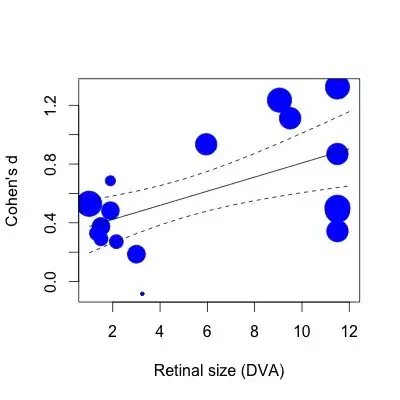I am using the metafor package in R. I have fit a random effects model with a continuous predictor as follows
SIZE=rma(yi=Ds,sei=SE,data=VPPOOLed,mods=~SIZE)
Which yields the output:
R^2 (amount of heterogeneity accounted for): 63.62%
Test of Moderators (coefficient(s) 2):
QM(df = 1) = 9.3255, p-val = 0.0023
Model Results:
se zval pval ci.lb ci.ub
intrcpt 0.3266 0.1030 3.1721 0.0015 0.1248 0.5285 **
SIZE 0.0481 0.0157 3.0538 0.0023 0.0172 0.0790 **
Below I have plotted the regression.The effect sizes are plotted proportionally to the inverse of the standard error. I realize that this is a subjective statement, but the R2 (63% variance explained) value seems a lot larger than is reflected by the modest relationship shown in the plot (even taking weights into account).

To show you what I mean, If I then do the same regression with the lm function (specifying study weights in the same way):
lmod=lm(Ds~SIZE,weights=1/SE,data=VPPOOLed)
Then the R2 drops to 28% variance explained. This seems closer to the way things are (or at least, my impression of what kind of R2 should correspond to the plot).
I realize, after having read this article (including the meta-regression section): (http://www.metafor-project.org/doku.php/tips:rma_vs_lm_and_lme), that differences in the way the lm and rma functions apply weights can influence the model coefficients. However, it is still unclear to me why the R2 values are so much larger in the case of meta-regression. Why does a model that looks to have a modest fit account for over half the heterogeneity in effects?
Is the larger R2 value because the variance is partitioned differently in the meta analytic case? (sampling variability v other sources) Specifically, does the R2 reflect the percent of heterogeneity accounted for within the portion that cant be attributed to sampling variability?. Perhaps there is a difference between "variance" in a non-meta-analytic regression and "heterogeneity" in a meta-analytic regression that I am not appreciating.
I'm afraid subjective statements like "It doesn't seem right" are all I have to go on here. Any help with interpreting R2 in the meta-regression case would be much appreciated.